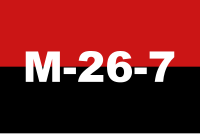
Back حركة 26 يوليو Arabic Movimientu 26 de Xunetu AST Рух 26 ліпеня Byelorussian Движение 26 юли Bulgarian ছাব্বিশে জুলাই আন্দোলন Bengali/Bangla Moviment 26 de Juliol Catalan Hnutí 26. července Czech 26. juli-bevægelsen Danish Bewegung des 26. Juli German Κίνημα της 26ης Ιουλίου Greek
| 26 July Movement | |
|---|---|
| Movimiento 26 de julio | |
 A modern impression of one of the flags of the 26th of July Movement | |
| Leaders | Che Guevara Alberto Bayo Fidel Castro Raúl Castro Camilo Cienfuegos Juan Almeida Bosque Frank País Celia Sánchez |
| Dates of operation | 1955–1962 |
| Headquarters | Tuxpan, Veracruz, Mexico (first) Havana, Cuba (last) |
| Active regions | Cuba |
| Ideology | Vanguardism Political pluralism Left-wing populism Left-wing nationalism Anti-imperialism |
| Political position | Left-wing to far-left |
| Opponents | Fulgencio Batista's Government, Cuban Army |
| Battles and wars | Operation Verano, Battle of La Plata, Battle of Las Mercedes, Battle of Yaguajay, Battle of Santa Clara |
The 26th of July Movement (Spanish: Movimiento 26 de julio; M-26-7) was a Cuban vanguard revolutionary organization and later a political party led by Fidel Castro. The movement's name commemorates the failed 1953 attack on the Moncada Barracks in Santiago de Cuba, part of an attempt to overthrow the dictator Fulgencio Batista.[1]
M-26-7 is considered the leading organization of the Cuban Revolution. At the end of 1956, Castro established a guerrilla base in the Sierra Maestra. This base defeated the troops of Batista on 1 January 1959, setting into motion the Cuban Revolution and installing a government led by Manuel Urrutia Lleó. The Movement fought the Batista regime on both rural and urban fronts. The movement's main objectives were distribution of land to peasants, nationalization of public services, industrialization, honest elections, and large-scale education reform.
In July 1961, the 26th of July Movement was one of the parties that integrated into the Integrated Revolutionary Organization (ORI) as well as the Popular Socialist Party (PSP) and the 13 March Revolutionary Directorate. On 26 March 1962, the party dissolved to form the United Party of the Cuban Socialist Revolution (PURSC), which held a communist ideology.[1]
- ^ a b "26th of July Movement | Cuban history". Encyclopedia Britannica. Retrieved 1 December 2019.
© MMXXIII Rich X Search. We shall prevail. All rights reserved. Rich X Search